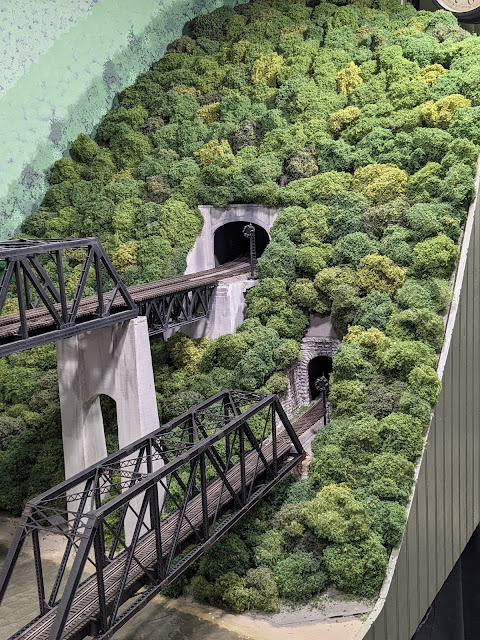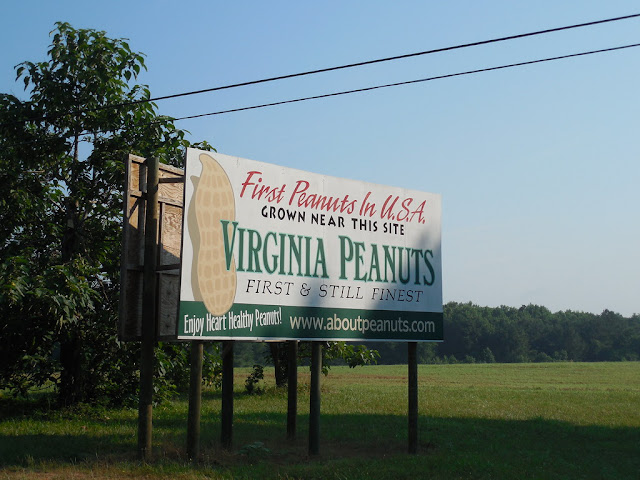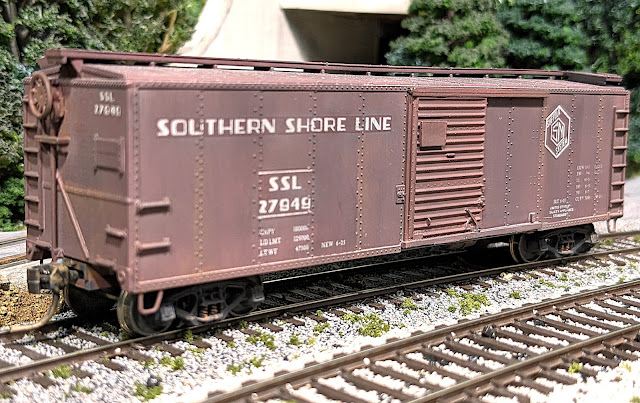the 'Roundhouse Kick', with almost comic regularity.
"This post is not about that. For the real story, here's my friend Keith."
Thanks, Chuck. Yes, the topic of our post today is an actual roundhouse, the one at SNR's Yaeger Yard in Segway, W. Va. -- and the kick it required to get it into compliance, and finished.
This portion of the layout came from the previous house, but the roundhouse had not been installed yet when we moved. When I finally did add tabletop for it to the benchwork, it sloped away from the turntable, by up to 1/4" at the extremes. But somehow my impatience overtook my OCD, and I determined it would be... fine. So I left it that way.
The impact, though, was that steam locomotives coming off the turntable would find their forward drivers dangling in space over the radial tracks, until finally passing the center of gravity, whereupon the whole rigid wheelbase would clunk down, hopefully onto the rails. Even with diesels -- the Stewart drives would bottom out on their belly tanks. Shameful.
Note the gap under the level. Yes that's over 1/8" drop in about 5". On track 6, at least.
 |
Alas, I can hear my father from beyond the grave: "You know that long thing with bubbles in it? It's called a LEVEL. Yeah -- the name might give you some idea what it's used for." 😄
I have hated this condition from the beginning -- but not enough to tear everything out and re-do it, since it was all wired and did sort of... work. I also never scenicked the area, knowing this really needed to be corrected first. And so it sat. For like, 25 years.
Finally this fall I could take it no more, and dove in. The whole project included a number of other improvements, as well.
1. Kicking (Jacking Up) the Roundhouse
This far downrange, there was no way I was going to tear benchwork apart. So I devised a plan to jack the roundhouse up to level (ish), using a graduated series of shims made from the Approximator's Best Friends: tongue depressors and business cards.
That worked pretty well actually -- just loosened the screws holding the floor in place and snaked the shims in from the front, one at a time. Even managed not to destroy much, or rip out any wires. After that, I did the same thing with the outside tracks. Note how high the back three tracks are, compared to the one just outside the roundhouse -- the last one yet to receive the fix. Look at its wicked angle up to the pit edge, too!
I then filled the big areas with cork, and filled in the air gaps under the tracks with sand, to get it all up to tie-level -- ready for a final coat of cinders, dirt, and weeds. At last!
2. The Doors
"Into this house we're born ♫♬♫♩...." Ahem. Anyway, the Walthers roundhouse kit originally had a full set of doors. However they tended to flop around and encroach on the tracks, so over time almost all had been removed and stacked in a pile out back. But I always liked the look of them, so I thought this would be a good time to try again. This round, I glued them in place and to each other -- that way they'll stay open and clear. It's always summer on the SNR!
3. SE Tower
The tower had always been just idling over there beyond the engine tracks (along with the stack of doors!), waiting for scenery, as well as for some way to compensate for the grade on the mainline. I built a raised site on cribbing, cut into the embankment, to get the tower to the right height and distance from the tracks.
4. RIP Track
The space vacated by the tower (and the stack of doors!) allowed room for what was kind of an afterthought: a freight car RIP track. A while back my friend Bob Bartizek installed a RIP track off the turntable on his Pennsylvania & Western, which I found cool -- and I'd been noodling with the idea ever since. ...Because the Yaeger yardmaster needs a little more to do. 😉
5. Clearance
If you've ever been yardmaster in Segway, you know that spinning a Mallet on the turntable is a dicey prospect, because the flanges barely clear on both ends -- and, that leaves the overhang to grind the couplers into the embankment over by the yard lead. Despite my having dug out a trough a few years ago, clearance was still insufficient, and couplers still snagged. Well no more -- dang if I wasn't gonna fix that too. I gouged it way the heck out, and even measured this time. Even built an ersatz retaining wall to hold back the fill, and fixed the scenery. Still tight, but look, Ma -- no scrapes!
6. Scenery at the Depot
Another item in the While You're At It Dept. was to finally finish the scenery over by the Segway depot. This included a rutted mud-n-gravel parking lot, and ballast etc. for the helper pocket and team track.
7. Armor
Lastly, what actually begat the entire project was that the roundhouse had been bumped so many times by the YM's elbow, or hooked by crewmen's shirts while reaching over it to uncouple on Mineshaft Gap siding up above, that the end-wall had completely departed the structure. Not counting being picked up off the floor a few times, it was just sitting there by its own inertia, along with its broken pieces and truant windows.
This badly needed to be addressed, and so I rebuilt the entire end-wall, armoring it with Evergreen 3/16" square tubing at every wall and roof joint. Anchors were installed along the floor edges throughout, to hold the structure in place in case of trauma, without gluing it down. Wise men have suggested plexiglas or sharpened utility poles for future protection, but I'm going to let it go a few rounds on unseen brute strength, and see how we do. At least it looks a whole lot better. ✅
Well that's it for this one project in numerous parts. Now back to the other two scenery projects that had stalled weeks ago!
Thanks as always for reading, and let me know what you think.




















































